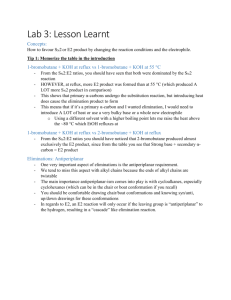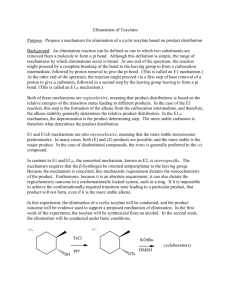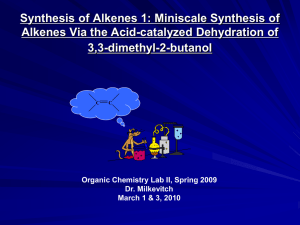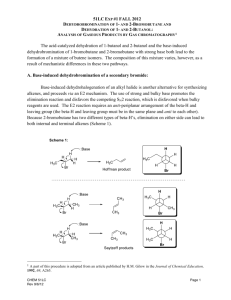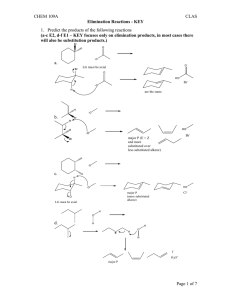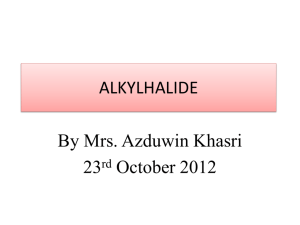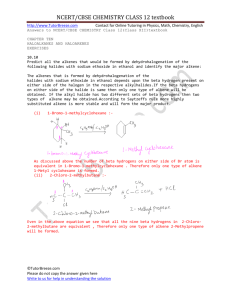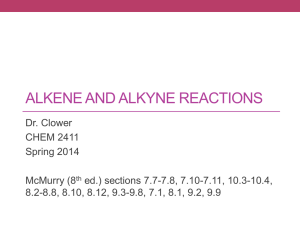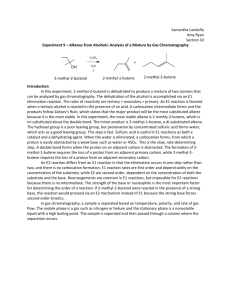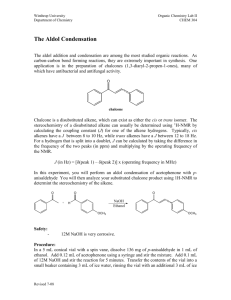spexp1
advertisement
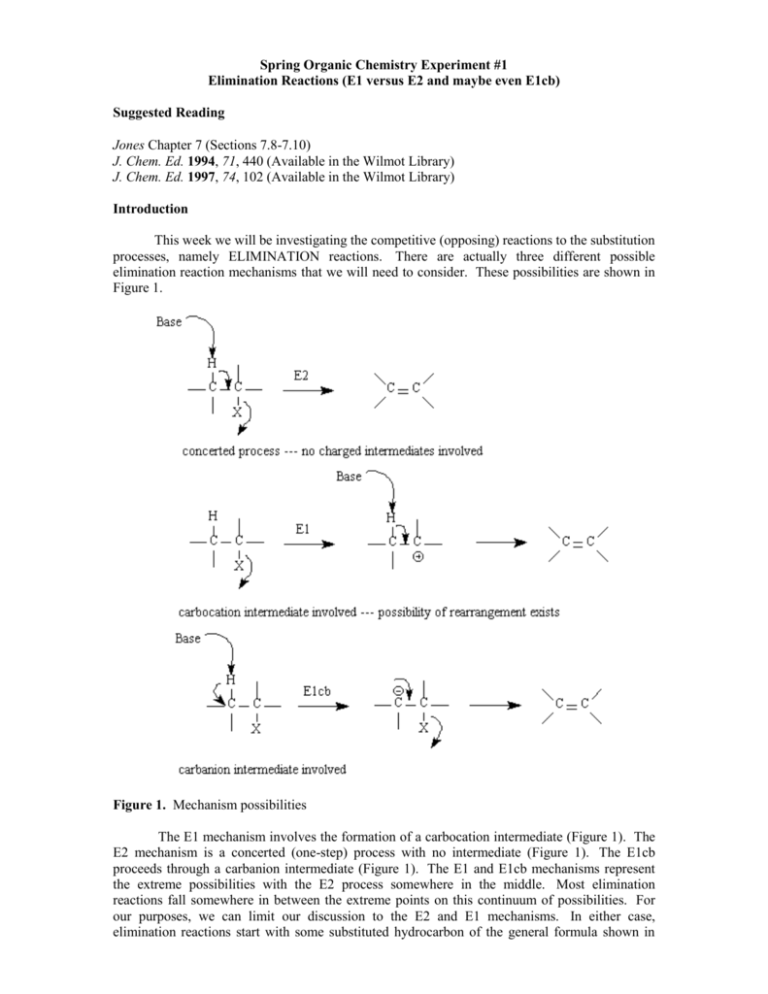
Spring Organic Chemistry Experiment #1 Elimination Reactions (E1 versus E2 and maybe even E1cb) Suggested Reading Jones Chapter 7 (Sections 7.8-7.10) J. Chem. Ed. 1994, 71, 440 (Available in the Wilmot Library) J. Chem. Ed. 1997, 74, 102 (Available in the Wilmot Library) Introduction This week we will be investigating the competitive (opposing) reactions to the substitution processes, namely ELIMINATION reactions. There are actually three different possible elimination reaction mechanisms that we will need to consider. These possibilities are shown in Figure 1. Figure 1. Mechanism possibilities The E1 mechanism involves the formation of a carbocation intermediate (Figure 1). The E2 mechanism is a concerted (one-step) process with no intermediate (Figure 1). The E1cb proceeds through a carbanion intermediate (Figure 1). The E1 and E1cb mechanisms represent the extreme possibilities with the E2 process somewhere in the middle. Most elimination reactions fall somewhere in between the extreme points on this continuum of possibilities. For our purposes, we can limit our discussion to the E2 and E1 mechanisms. In either case, elimination reactions start with some substituted hydrocarbon of the general formula shown in Figure 2. In most cases, the starting compound is an alkyl halide (where the leaving group is Br, Cl, or I) or an alcohol. Figure 2. Compound capable of undergoing an elimination reaction NOTE: if the starting material is an alcohol, the OH group will need to be activated prior to leaving (also true for substitution reactions). Remember that OH groups are POOR leaving groups because they leave as OH- (strong base). Typical activating processes (which converts a poor leaving group into a good leaving group) include: (1) reactions performed under acidic conditions (2) conversions to tosylates/mesylates See Section 7.4f of Jones (pages 293-297) The products of elimination reactions are alkenes. Elimination reactions generate products with specific regiochemistry. In fact, many reactions give a mixture of products with differing regiochemistry. The distribution of these products is based upon the regiochemistry predicted by Zaitsev's rule. Interestingly, Alexander Zaitsev was a colleague of Vladimir Markovnikov at the University of Kazan. They actually worked "together" in their research. Markovnikov investigated the regiochemistry of the "forward" (addition) process by adding HI to alkenes to prepare alkyl iodides (we will talk about this in class when we look at addition reactions to alkenes and alkynes: called Markovnikov’s rule – see pages Section 9.6 of Jones). Zaitsev investigated the "reverse" process (elimination) by performing a dehydrohalogenation of the alkyl iodides prepared by Markovnikov. At the same time that Markovnikov was forming his rule, Zaitsev was forming Zaitsev's rule: When HZ is removed from a compound to form an alkene, the hydrogen is lost preferentially from the carbon atom that has the fewer number of hydrogens adjacent to the carbon holding the Z group. The result is the formation of the more highly substituted alkene. By looking at the following example (Figure 3), we may observe Zaitsev's rule: Figure 3. The removal of different hydrogens by base leads to different regioisomeric alkene products. Notice that the favored product is the one that forms the MORE HIGHLY substituted alkene. The basic rule here is that the more highly substituted alkene forms because the transition state resembles the product (a late transition state). The transition state of lowest energy is the one that resembles the more stable product and, therefore, controls the course of the reaction. We assume that this reaction is under thermodynamic control. Be careful, however, for Hofmann elimination where the LEAST substituted alkene dominates (read Sections 7.8b, pages 313-314 and 7.9b pages 322-327 of Jones). In the example above, 2-pentene is more stable than 1-pentene because in the formation of the major product we are generating a more highly substituted (and, therefore, more stable) alkene. You may want to review the information in the Jones text pertaining to alkene stability (Section 3.6 pages 115-118 of Jones). Can other products form? The answer is most certainly yes, but it is not simple. If any elimination is occurring, it is usually accompanied by multiple product formation. Multiple products form because of COMPETITION (just like in substitution). This competition can take a variety of forms. We can have competition between different types of elimination reactions (E2 vs E1). We can have competition between elimination and substitution (E2 vs SN2 and E1 vs SN1). The most severe cases occur when we have our leaving group attached to a secondary carbon (as we do today). So, be careful and be on the look out for multiple products to form. Extension In the early 1990's Professor David Todd made an interesting discovery about the course of dehydration for 2-methylcyclohexanol which he called the ""Evelyn Effect". You should read about his discovery in the following reference: J. Chem. Ed. 1994, 71, 440. The basic idea here is that the proportions of the various alkene products changes as a function of time. The question is why does this happen and how can we explain the variability in percentages of alkene products. In order to observe the Evelyn effect, we will collect fractions at various time intervals (see J. Chem. Ed. 1997, 74, 102) and evaluate the results by GCMS. Your objective is to use the information collected to propose a mechanistic rationale that is consistent with the data. Standards The following compounds will serve as standards for our experiment. Any of the following could potentially show up in the GCMS data. 1-methylcyclohexene 4-methylcyclohexene methylenecyclohexane vinylcyclopentane 3-methylcyclohexene Procedure In this week's experiment, you will perform the acid-catalyzed dehydration of 2methylcyclohexanol. The elimination of H+ and H2O from your starting material yields a mixture of alkene products. You are to measure out 150 mmol of your starting material into a roundbottom flask and mix in 5 mL of 85% phosphoric acid. Add a stir bar and setup for a modified fractional distillation. This modification involves the use of the vertical column without packing. You will perform the reaction in a distillation apparatus so that the alkene products can continuously distill out of the boiling pot as soon as they are formed. Be careful to adjust the temperature of your reaction mixture so that the temperature is ABOVE the boiling point of the alkene products, but BELOW the boiling point of the alcohol starting material. This design insures that ONLY the alkenes and the water (by-product) will codistill from the reaction mixture leaving the alcohol behind. It is recommended that you distill slowly (1-2 drops per second) and monitor the temperature in the still head throughout the course of the reaction. The still head temperature should remain below 120 °C. You are to collect your distillate in fractions at self-selected time intervals (start timing when the first drop of distillate appears). You should acquire 1 mL of distillate at each time point. GCMS work-up: Collect the 1 mL sample in a 10 mL graduated centrifuge tube. Dilute the distillate with 1 mL of diethyl ether and then wash with one 5 mL portion of 1.5 M NaOH solution. Remove the organic layer carefully using a Pasteur pipette and dry over anhydrous magnesium sulfate. Transfer the liquid to a GCMS vial and place in the appropriate slot in the autosampler. Upon completion, remove any of the ether solvent, dilute the sample with CDCl 3/TMS and acquire a 13C NMR spectrum. Disassemble the distillation apparatus and discard the residue in your boiling flask in the ACIDIC waste container in the fume hood. All aqueous washing can be rinsed in the sink with copious amounts of water. Residual distillate should be discarded in the NON-HALOGENATED waste container.
